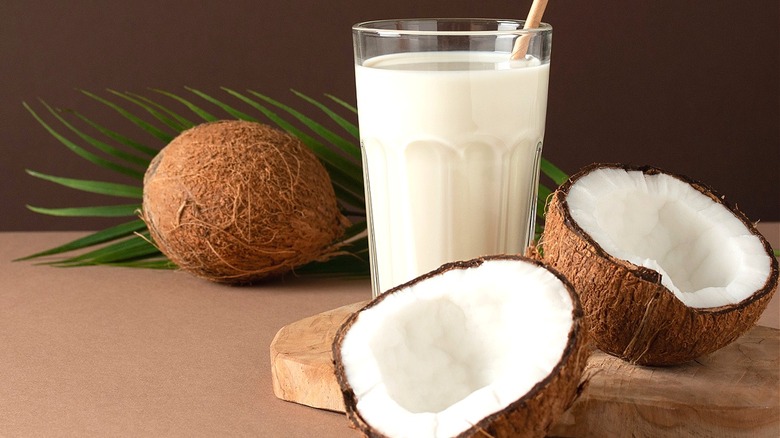Making Homemade Coconut Milk Is So Easy With This Kitchen Tool
Purchasing a carton of coconut milk is much easier than making your own. However, even if you choose one of the best coconut milk brands, you'll miss out on the rich flavor and velvety consistency of homemade. Maybe the effort required to get inside a fresh coconut is putting you off. Luckily, all you need to make deliciously creamy homemade coconut milk is a mature coconut, water, a high-powered blender, and the right tool to drain this tricky fruit. Instead of attempting to pry open a shell with brute force, simply utilize your corkscrew.
Instead of piercing fresh coconut with a screwdriver or another unclean garage tool, use a winged corkscrew for a cleaner, more reliable option. This kitchen-friendly tool will release coconut water for easy drinking, and fresh coconut milk is only a couple more steps away. First, locate the eyes of the coconut — the three small circles near the top of the fruit. Press each one with your fingers and puncture the largest indentation with the spiral "worm" of your corkscrew. By twisting downward (as you would open a bottle of wine), you can pull out a decent chunk of coconut flesh and drain coconut water in a flash. Pierce two of the holes to make pouring the liquid easier. Luckily, this brilliant method works with more than one type of corkscrew.
Simplify breaking into your coconut by using a corkscrew
Fortunately, you don't need the best wine opener on the market to take advantage of this technique. While a winged corkscrew has a convenient handle to twist the worm into the coconut flesh, a key corkscrew is a notable alternative. To use a key corkscrew, locate the small knife on the end of your tool. Use the blade to bore through two of the coconut eyes. Since the knife is on the shorter side, you may not be able to cut all the way through the rind and flesh.
Once you've made some headway, switch to your corkscrew and twist down through the eyes of your fruit. After twisting the worm through each eye, pull the tool straight out, revealing small plugs of meat. Turn your coconut upside down and shake the sweet water into a bowl large enough to catch any splashes. To make extra flavorful coconut milk, you'll want to use every last drop of this precious juice. Regardless of the type of corkscrew you decide to use, once you've successfully drained your coconut, you're ready to make delicious homemade coconut milk.
Homemade coconut milk is possible with the right preparation
The best homemade coconut milk is made with raw coconut flesh, water, and coconut water. Using a combination of water and coconut water gives homemade coconut milk a fresh taste you can't find in store-bought varieties.
Now that you have the bowlful of coconut water, you can move on to breaking into your fruit. To keep the process simple, wrap your coconut in a tea towel to contain the pieces and knock the fruit a few times with a hammer. You can achieve similar results by tapping your coconut along the corner of a concrete step or curb. Once the fruit splits apart, work to remove the flesh from the tough outer layer with a butter knife or metal spoon. Then, all you need to do is add coconut meat, coconut water, and however much extra water you desire to your high-powered blender and blend for around three minutes or until all the larger pieces of coconut meat have been broken down.
Once you've successfully strained the mixture using a nut milk bag or cheesecloth, you're ready to enjoy the fruits of your labor. This extra creamy beverage will stay fresh for up to three days when stored correctly. Try homemade coconut milk with your morning cereal or in your favorite curry, in a delicious smoothie or dairy-free waffles.


